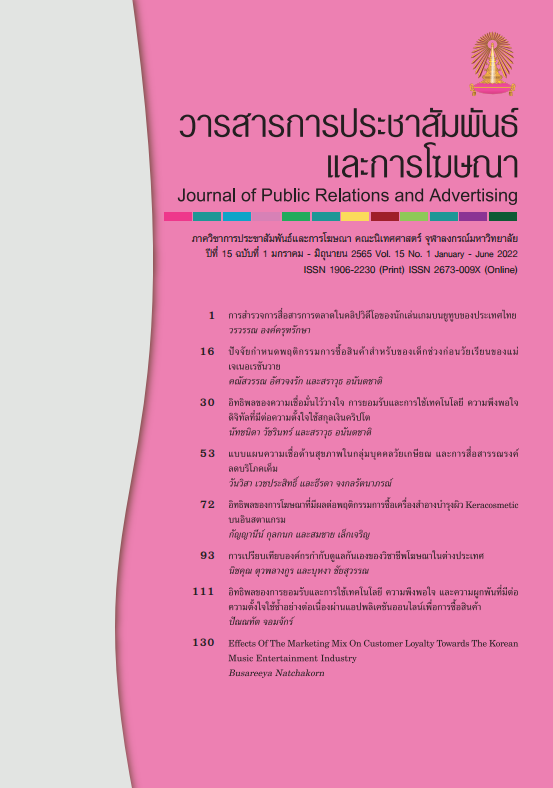Health Belief Model of the Retirees and Reducing Sodium Intake Campaign
Main Article Content
Abstract
The purposes of this quantitative research were to study the media exposure, attitude, Health Belief Model (HBM) of retired people and persuasive messages to reduce salty consumption campaigns. The respondents include 400 senior citizens who live in Bangkok, Thailand. Questionnaires were distributed randomly via social media and via snowball technique. Both descriptive and inferential statistical analysis were applied to find the differences and co-relation among variables with the significance level at 0.05 The results showed that the respondents were mostly exposed to campaign social media such as Facebook, Website and YouTube. Their attitude toward persuasive messages were rated at the high level. They preferred the campaign messages focusing on the severity of the disease and on adaptability in a daily life. Moreover, their Health Belief Model (HBM) was rated at the high level. It was also demonstrated that retired persons, who had different education and income, had the different level of Health Belief Model (HBM) with statistical significance level of 0.05. Moreover, it was found that their attitude toward persuasive messages were correlated with the Health Belief Model (HBM) with statistical significance level at 0.01. Lastly, the media exposure was correlated with the Health Belief Model (HBM) with statistical significance level at 0.01.
Article Details
References
กรมควบคุมโรค. (2562). จํานวนและอัตราผู้ป่วยปี 2559-2561. กรุงเทพฯ: กระทรวงสาธารณสุข.
กันตพล บันทัดทอง. (2557). พฤติกรรมการใช้เครือข่ายสังคมออนไลน์และความพึงพอใจของกลุ่มคน ผู้สูงอายุใน เขตกรุงเทพมหานคร. (วิทยานิพนธ์ปริญญามหาบัณฑิต), มหาวิทยาลัยกรุงเทพ,
กุลยา ตันติผลาชีวะ. (2551). สุขกายกับวัยสูงอายุ. กรุงเทพฯ: เรือนปัญญา.
ณรงค์ เส็งประชา. (2538). มนุษย์กับสังคม. กรุงเทพฯ: โอเดียนสโตร์.
ธัญลักษณ์ โมราษฎร์. (2548). ศึกษาผลของการใช้โปรแกรมส่งเสริมโภชนาการโดยประยุกต์ แบบแผนความเชื่อด้านสุขภาพ และการดูแล ตนเองของผู้สูงอายุโรงพยาบาลขอนแก่น. (วิทยานิพนธ์สาธารณสุขศาสตรมหาบัณฑิต), มหาวิทยาลัยขอนแก่น.
นพวรรณ เปียซื่อ. (2561). การดูแลโภชนาการเพื่อควบคุมโรคไม่ติดต่อเรื้อรังในชุมชน. กรุงเทพ: จุดทอง.
บุญเทือง โพธิ์เจริญ. (2551). แผนที่ชีวิตวัยเกษียณ. กรุงเทพฯ: ฐานบุ๊คส์.
ปานชีวา แลบุญมา. (2551). แบบแผนความเชื่อด้านสุขภาพและพฤติกรรมการสูบบุหรี่ของประชาชนในเขตสถานอนามัยบ้านแม่ปุ อําเภอแม่พริก จังหวัดลําปาง. (วิทยานิพนธ์ปริญญามหาบัณฑิต), มหาวิทยาลัยเชียงใหม่.
วิไลรัตน์ บุญราศี. (2559). แบบแผนความเชื่อและพฤติกรรมของพนักงานโรงไฟฟ้าแม่เมาะที่มีภาวะอ้วน ลงพุง. (วิทยานิพนธ์ปริญญาสาธารณสุขมหาบัณฑิต), มหาวิทยาลัยธรรมศาสตร์,
ศุภกานต์ นุสรณ์รัมย์. (2557). ความสัมพันธ์ระหว่างความเชื่อด้านสุขภาพกับภาวะสุขภาพของผู้สูงอายุ. (วิทยานิพนธ์ปริญญามหาบัณฑิต), มหาวิทยาลัยบูรพา,
สายหยุด มูลเพ็ชร์. (2558). การสํารวจปริมาณโซเดียมที่ขับออกมาทางปัสสาวะและปัจจัยที่มีผลต่อการกินเค็มในกลุ่มผู้ที่มีความเสี่ยงต่อการเป็นความดันโลหิตสูง โรงพยาบาลตําบลดอนแก้ว อําเภอแม่ริม จังหวัด เชียงใหม่. (วิทยานิพนธ์ปริญญามหาบัณฑิต), มหาวิทยาลัยราชภัฏเชียงใหม่.
หทัยการต์ ห้องกระจก. (2559). อิทธิพลของความแตกฉานด้านสุขภาพ การรับรู้สมรรถนะแห่งตน และการสื่อสาร ระหว่างผู้ป่วยกับบุคลากรสุขภาพต่อพฤติกรรมการดูแลตนเองของผู้ป่วยโรคความดันโลหิตสูงปฐมภูมิ. (วิทยานิพนธ์ปริญญามหาบัณฑิต), มหาวิทยาลัยบูรพา.
Abraham C, & P, S. (2004). Health belief model. Behavior Predicting Health, 28-80.
Nachiketas Nandakumar, & Sivakumaran, B. (2017). Threat, efficacy and message framing in consumer healthcare. Marketing Intelligent & Planning, 35, 442-457.
Rosenstock M, Strecher J, & Becker H. (1988). Social leaning theory and the health belief model. Health Education Quarterly, 15(2). 175-183.
Rosenstock M. (1974). Historical origins of the health belief model. Health Education, Monographs, 2, 328-335.
Skinner C, Tiro J, & Champion V. (2015). Theory research, and United Nations Development Programme. Discussion paper: addressing the social determinants of noncommunicable diseases. Health behavior and health education.
Soleymani L, & L, S. (2015). Knowledge, attitude and practice declaration of elderly in Ahram city toward nutrition behavior in 201. Iranian South Medical Journal, 18(2), 70-82.
Soltani R, Torabi A, Hasanzadeh A, & G, S. (2017). Behind Fruit and Vegetable Consumption Among the Elderly with Functional Constipation: A Study Based on the Health Belief Model. Mod Care Journal, 18(1). doi:10.5812/modernc.63387.
Strecher VJ, DeVellis BM, Becker MH, & IM, R. (1986). The role of self-efficacy in achieving health behavior change. Health Education Quarterly, 13, 73-92.
Taejin Jung, & Brann, M. (2555). Analyzing the extended parellel process model and health belif model constructs in texting while driving news coverage in leading U.S. news media outlets. International Journal of Health Promotion and Education. 52(4). 210-221.
Thapaliya, R. (2018). An Extension of The Extended Parallel Process Model (Eppm) To promote healthy behaviors. University of oklahoma Graduate College,
World Health Organization, (2007). Reducing salt intake in populations - Report of a WHO Forum and Technical Meeting. Organization.


